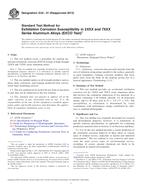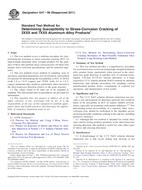Potrebujeme váš súhlas na využitie jednotlivých dát, aby sa vám okrem iného mohli ukazovať informácie týkajúce sa vašich záujmov. Súhlas udelíte kliknutím na tlačidlo „OK“.
ASTM B646-12
Standard Practice for Fracture Toughness Testing of Aluminum Alloys
Automaticky preložený názov:
Štandardné praktiky pre lomovej húževnatosti Testovanie hliníkových zliatin
NORMA vydaná dňa 1.5.2012
Informácie o norme:
Označenie normy: ASTM B646-12
Poznámka: NEPLATNÁ
Dátum vydania normy: 1.5.2012
Kód tovaru: NS-7548
Počet strán: 5
Približná hmotnosť: 15 g (0.03 libier)
Krajina: Americká technická norma
Kategória: Technické normy ASTM
Kategórie - podobné normy:
Anotácia textu normy ASTM B646-12 :
Keywords:
aluminum alloys, fracture toughness, linear-elastic, plane-strain, plane stress, quality assurance, ICS Number Code 77.120.10 (Aluminium and aluminium alloys)
Doplňujúce informácie
| Significance and Use | ||||||||||||||
|
This practice is provided to develop and maintain uniformity in practices for the evaluation of the toughness of aluminum alloys, particularly with regard to supplier qualification, quality assurance, and material release to specifications. It is emphasized that the use of these procedures will not alter the validity of data determined with specific test methods, but provides guidance in the interpretation of test results (valid or invalid) and guidance in the selection of a reasonable test procedure in those instances where no standard exists today. |
||||||||||||||
| 1. Scope | ||||||||||||||
|
1.1 Fracture toughness is a key property for a number of aluminum alloys utilized in aerospace and process industries. Fracture toughness testing is often required for supplier qualification, quality control, and material release purposes. The purpose of this practice is to provide uniform test procedures for the industry, pointing out which current standards are utilized in specific cases, and providing guidelines where no standards exist. This practice provides guidance for testing (a) sheet and other products having a specified thickness less than 6.35 mm (0.250 in.), (b) intermediate thicknesses of plate, forgings, and extrusions that are too thin for valid plane-strain fracture toughness testing but too thick for treatment as sheet, such as products having a specified thickness greater than or equal to 6.35 mm (0.250 in.) but less than 25 to 50 mm (1 to 2 in.), depending on toughness level, and (c) relatively thick products where Test Method E399 is applicable. 1.2 This practice addresses both direct measurements of fracture toughness and screening tests, the latter recognizing the complexity and expense of making formal fracture toughness measurements on great quantities of production lots. 1.3 The values stated in SI units are to be regarded as the standard. The values in inch-pound units given in parenthesis are provided for information purposes only. 1.4 This standard does not purport to address all of the safety concerns, if any, associated with its use. It is the responsibility of the user of this standard to establish appropriate safety and health practices and determine the applicability of regulatory limitations prior to use. |
||||||||||||||
| 2. Referenced Documents | ||||||||||||||
|
Podobné normy:
Historická
1.5.2009
Historická
1.5.2009
Historická
1.5.2013
Historická
1.9.2011
Historická
1.5.2013
Historická
1.5.2013
Odporúčame:
Aktualizácia zákonov
Chcete mať istotu o platnosti využívaných predpisov?
Ponúkame Vám riešenie, aby ste mohli používať stále platné (aktuálne) legislatívne predpisy
Chcete vedieť viac informácií ? Pozrite sa na túto stránku.



 ASTM G110-92(2009)..
ASTM G110-92(2009).. ASTM G112-92(2009)..
ASTM G112-92(2009).. ASTM G34-01(2013)..
ASTM G34-01(2013).. ASTM G47-98(2011)..
ASTM G47-98(2011).. ASTM G64-99(2013)..
ASTM G64-99(2013).. ASTM G66-99(2013)..
ASTM G66-99(2013)..
 Cookies
Cookies
